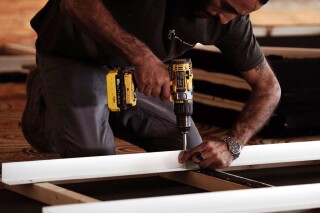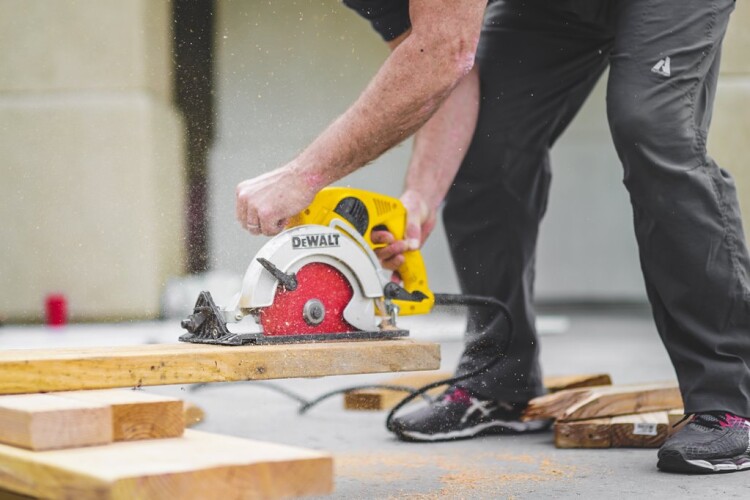Perhaps to no surprise, the power tools market remains buoyant. Global forecasts show that by 2027 more than 600 million tools will be sold across the commercial and residential market – more than double the number recorded in 2015. Statista data also shows the power-driven hand tools market will generate more than US $56bn (£45bn) by 2025.
For more than 60 years, buyers have had a relatively simple choice on which type of power tool they want to purchase, namely mains or cordless. But for how much longer will that be the case?
In recent years, the construction industry has witnessed a remarkable shift towards cordless power tools. The technology continues to get better with each passing year as professionals and DIY enthusiasts alike embrace the benefits of portability, efficiency and enhanced safety.
Undoubtedly, mains-powered tools still have their place on the job site, particularly for heavy-duty jobs, but the momentum is also undeniably moving towards cordless solutions, particularly for portable tools used on site.
As cordless technology continues to advance, the question arises: When will mains power tools become a thing of the past?
The numbers behind the cordless revolution
The growing popularity of cordless power tools is evident from market statistics. Sticking with industry value, the cordless tools market is on track to hit just under $47bn – more than doubling in value in just nine years. When we drill down (sorry) into the reasons behind that, the market shift towards cordless is clear.
A study by Technavio showed that cordless tools accounted for 81.1% of sales last year in the UK professional power tools market, with corded tools making up just 18.9%. AS recently as 2018 that split was 50-50, according to the European Power Tool Association. One of the fastest-growing power tool brands saw an overwhelming 99% of its tools sold from its battery-powered platforms.
Generally speaking, cordless tools have shaken off their reputation for not being as good as their mains equivalent. Acceptance has grown across all sectors. Coupled with that is the greater need for fastening tools and the booming construction industry across developing nations.
As demand for power tools increases, and with the use of lithium-ion batteries becoming more widespread, the cordless tools segment is projected to dominate the market's growth from 2022 to 2027.
Lithium-ion batteries: pioneering the cordless revolution
In the early days, cordless power tools struggled to match the power and performance of their plug-in counterparts. However, the introduction of lithium-ion battery technology revolutionised the industry.

The first lithium-ion battery-operated power tool was introduced to the market 20 years ago, in the autumn of 2003. It was the IXO cordless screwdriver by Bosch and it was powered by a single 3.6V lithium-ion cell.
Developed by materials scientist John Goodenough in 1980, lithium-ion batteries offered a remarkable charge-to-weight ratio, making them ideal for portable battery-powered tools.
The adoption of this technology by leading brands, like Milwaukee and Makita, propelled cordless power tools into the mainstream but adoption faced resistance from battery anxiety and many buyers preferred to stick with what they knew.
But battery technology continues to develop. Reducing the cost of cordless power tools, improving their versatility, and eroding any residual battery anxiety will only continue to drive up the market share of cordless tools.
The other factor to consider here is the price. While prices of materials and equipment go up, the price of lithium batteries comes down. According to data collected by Bloomberg, the volume-weighted average price of a typical lithium-ion battery has plunged by more than $1,000 since 2010 and continues to decrease incrementally each year.
The electric vehicle market is the biggest contributing factor to that. So too is its role in the power tools market.
Everything else is going smart and so are cordless power tools

We have smartphones, smart homes, and every appliance you can think of that is adopting smart technology. The same is happening with power tools.
Brands like Milwaukee are leaders in this space. They introduced their tool connectivity platform, One-Key, enabling users to control and monitor their equipment remotely through smartphone apps. By its own description, the IoT-connected smart tools are backed by the industry’s largest Bluetooth tracking community to help its users connect sites, people, and equipment - and crucially help locate stolen equipment.
In short, the power tools market is branching out beyond just the tool. These smart tools also offer features like security lockouts, inventory management, and tool customisation, all built to optimise performance and enhance safety on job sites.
While Milwaukee leads the way, others are following. Brands, such as Bosch and Festool, are also developing their own smart tool technology, creating a range of connected cordless solutions that, in the words of Hilti’s GB vice-president Thibaud Lefebvre, will reduce inefficiencies at a time the industry is battling tight schedules and labour shortages, defending margins, and managing risk.
Improved safety
One of the biggest advantages of cordless is the removal of the huge electrical current that flows through the mains alternative. Back in 2016, the USA’s Bureau of Labor Statistics showed that 53% of all fatal electrical injuries were in the construction industry. Not all of that can be attributed to power tools but they do factor into this conversation.
As well as the removal of the electric current, the absence of trailing cables, and the elimination of cumbersome 110V transformers, batteries are playing a major role in reducing workplace hazards and improving job site mobility.
Some construction sites have even banned corded power tools altogether due to safety concerns. Additionally, cordless tools do not require pre-use portable appliance testing (PAT), streamlining equipment readiness.
There are a lot of positives, therefore, so what is holding cordless tools back from a complete market takeover?
There is only one answer to this question: the battery.
There is no getting over the fact that moving to cordless means you are constantly needing to keep on top of your battery charge. The standard lithium-ion battery will last up to eight hours on the job, depending on how powerful the battery is and what tool is being used.
Every product has a lifespan. The average cordless power tool product – powered by a lithium-ion battery – will last no more than three years if used frequently. Manufacturers claim that users can expect to get approximately 1,000 charge cycles out of a battery before it packs up. Research in 2009 showed that lithium-ion battery-powered tools had an estimated 500 charge cycles.
Ultimately, it is my opinion that lifespan is one of the only factors why corded tools remain on the market today. Quality corded tools still outlast the battery alternative by at least a couple of years. Most people today will know someone who has still got a corded drill that they purchased in the 1980s and it is still going strong.
While progress has been made on this front, once cordless tools overcome the issue of longevity, we are going to be looking at the rapid end of the corded tools.
How long will it be before mains power tools are obsolete?
With a projected compound annual growth rate (CAGR) of 5.02% from 2022 to 2027, the cordless power tools market is set to continue its expansion, driven by the increasing demand for power tools, DIY building products, and advancements in lithium-ion battery technology.
Given this rapid progress, it is only a matter of time before cordless power tools become the new standard for professionals and enthusiasts alike.
The data shows we have seen a huge jump in just five years, from a 50:50 global split to 81:19 in favour of cordless. It is conceivable, as the technology continues to develop and production on corded tools winds down, the ratios will be 90-10 by 2027.
Give it another 10 years and I’m not sure there will be any mains power tools at all. The sand timer is ticking. The construction industry is undeniably experiencing a monumental shift towards cordless power tools. With a plethora of advantages, including portability, enhanced battery runtimes, smart features, and improved safety, cordless tools have become the preferred choice for most.
The day when mains power tools disappear from shelves and become a relic of what the construction industry once was is just a matter of years away.
Got a story? Email news@theconstructionindex.co.uk



